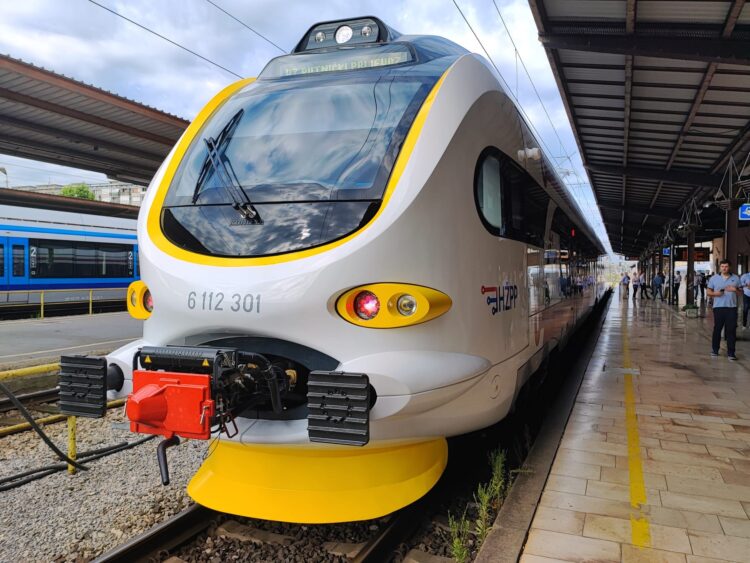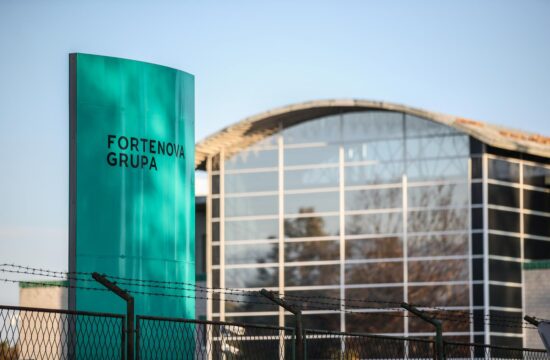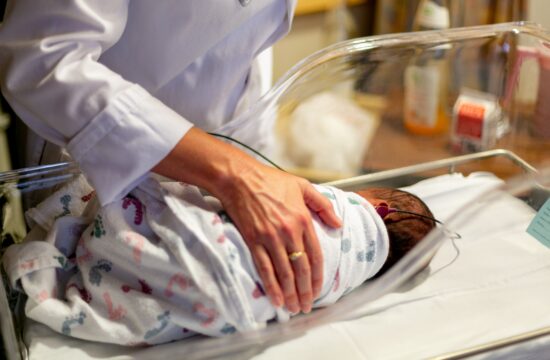
Demand for rail travel is high, but national operators and startups are competing with “unreasonably low prices” for flights, so experts are calling for a Europe-wide kerosine tax, say AFP, dpa, Fena, Hina and STA journalists within the European Newsroom project. Pročitaj više
Politicians, transport experts and business people alike are criticising the state of the railway infrastructure and the heavy subsidising of airborne travel.
In the fight against climate change, the European Commission wants twice as many high-speed trains to run on European tracks by 2030 and three times as many high-speed trains by 2050. This is intended to reduce CO2 emissions in the transport sector. For German railway operator Deutsche Bahn and other European railways, far more investment is needed to expand high-speed rail transport in Europe as envisaged by the Commission.
If the so-called Green Deal is to succeed, “the EU and the member states will have to make considerable additional investments and invest in network expansion throughout Europe”, Deutsche Bahn announced in July. The infrastructure measures currently in planning or under construction are not sufficient to achieve a doubling of high-speed traffic by 2030.
Expensive trains, cheap flights
Climate-friendly rail is often more expensive than air travel on the same route, environmental organisation Greenpeace concluded after comparing ticket prices for both means of transport on 112 routes across Europe at several booking times. According to the organisation, 71 percent of the tickets for rail travel were more expensive than those for air travel, which is more damaging to the climate.
The testers registered the most glaring price difference on the Barcelona-London route, which cost up to €384 by train. That was 30 times more than by plane with a ticket price of €12.99.
“More and more people want to travel by train and do without flights, but the lack of a kerosene tax and further climate-damaging subsidies for the airline industry distort prices. This is a crash landing for many good intentions and climate protection”, Greenpeace transport expert Marissa Reiserer said, calling for a Europe-wide kerosene tax of 50 cents per litre.
That would bring in annual revenues of €46.2 billion. These funds would have to be channelled into the rail infrastructure. German federal Green politician Anton Hofreiter also demanded flying to be made more expensive and called for a European kerosene tax too.
Rail transport is “subject to various taxes and fees,” in particular for using the infrastructure, said Philipp Kosok, an analyst at the German think tank Agora. There is also no centralised site to consult timetables and compare prices.
“There’s not really a European approach to train travel at the moment,” said Chris Engelsman, the co-founder of the Belgian-Dutch startup European Sleeper that inaugurated a nightline between Berlin and Brussels in May.
Another train startup co-founder, French Adrien Aumon, stated: “I realised that it was almost impossible to travel in Europe (without flying). People were asked to get off the planes, but without necessarily offering them solutions.”
His startup Midnight Trains is partnering with a night train maker to relaunch the once-popular Paris–Milan–Venice line in 2025.
Modernisation is underway, but change takes time
It seems like attention to and maintenance of the railway infrastructure has been somewhat neglected in various European countries due to insufficient investments in the past. Billions of euros are being earmarked by national governments, rail operators and the EU alike. But it will take time until the rejuvenation and expansion will be completed.
In Bosnia and Herzegovina, the precarious state of the railway infrastructure is credited to the war in the 1990s and insufficient financial investments. However, Edin Forto, the country’s minister of transport and communications, made the construction and revitalisation of railway infrastructure domestically and internationally a priority of his mandate.
Advances were made by the reconstruction of the Sarajevo–Mostar route. New passenger trains which are capable of a maximum speed of 220 km/h were acquired, and the project cost about €67.5 million. The railway line is located on the pan-European 5C-Corridor which connects Budapest (Hungary) to Ploče (Croatia). This means that more 50% of the line lies on BiH’s territory and needs to be modernized and maintained.
In Croatia, where the 5C corridor ends, highway networks have been the focus of investments for decades, leaving the rail work infrastructure in a rather neglected state. The government aims to improve matters, but this will take time and funds. Construction and modernisation projects are underway, aiming to revitalise and modernise 30% (780 kilometres) of the total network according to EU standards by increasing the capacity of railway lines, speed of travel and safety.
The projected speed of passenger trains is 160 kilometres an hour, while freight trains will be able to develop a speed of 120 km/h which is not considered high-speed. Until 2030, €5.4 billion has been earmarked for this with 85% of the necessary funding coming from EU co-financing.
About 25 major infrastructure projects are currently being implemented in Croatia. Most of the investments are for projects along two transport corridors: The RH1, running from the Slovenian border to the Serbian border, and the RH2, stretching from the northern Adriatic port city of Rijeka to the border with Hungary. The RH2 will connect the Iberian Peninsula to the TEN-T European network.
The EU’s network policy TEN-T aims to develop a coherent and efficient transport infrastructure across the European Union, comprising railways, waterways, roads, ports, airports and terminals.
Two core European corridors of the trans-European transport network, the Mediterranean Corridor and the Baltic-Adriatic Corridor run through Slovenian territory. The country functions as a transit country and has just over 1,200 kilometres of railway lines. 875 km of these are still single-track. But the growing importance of green mobility and the need for more intensive investment in rail infrastructure has led to a new significant increase in the country’s investment budget.
In 2023, the Slovenian Infrastructure Directorate can avail of €423.7 million for investment in rail infrastructure. The country has also taken advantage of opportunities through various EU mechanisms.
German minister: Investment boom in years ahead
The German government is planning to provide national railway operator Deutsche Bahn with billions of Euro in additional funding from its Climate and Transformation Fund (KTF). By 2027, the federally owned railway is to receive €12.5 billion from the fund.
The country’s rail network is in part dilapidated and in need of fundamental renovations but it is likely to take several years before measures will be noticeable to passengers.
Germany’s government has been slow to prioritise the issue. “We will do everything in our power to continue the enormous investment boom in the coming years – with the goal, confirmed in the coalition’s decision in March, of providing a total of up to €45 billion in additional funding by 2027,” German Federal Transport Minister Volker Wissing recently said.
With around 38.000 kilometres, the German rail network is the largest and one of the most complex in Europe and thus poses particular challenges for operators – such as a high rate of trains running late. This has consequences for cross-border travel.
Swiss railways SBB for example announced that they are using more replacement trains in Basel in order to offer punctual connections in Switzerland. Travellers arriving from Germany then have to switch trains for further travel in Switzerland.
93 percent of Swiss trains are on time. Since spring, a new tool shall help to improve energy efficiency and punctuality. One hour before departure, SBB calculates the optimal travel strategy based on the weather and traffic situation. With the tool, train drivers know exactly how many seconds they are behind schedule during the journey so that they can take countermeasures.
However, not everybody is happy about the plans to extend the railway networks. In June, French police clashed with thousands of protesters who sought to stop the construction of a new high-speed train line between France and neighbouring Italy. Supported by the EU, the new line should eventually link France’s Lyon and Turin in Italy, with a 57.5-kilometre tunnel through the Alps. The estimated cost is more than €26 billion. Supporters say it will greatly ease freight road traffic but opponents say the ecological damage risks are devastating and that springs already started to dry up due to the works.
Renaissance of the sleeper train
Night trains have made a comeback in Europe thanks to their low-carbon footprint, but after years of neglect, the Renaissance has had a bumpy ride. “Operating night trains is very difficult, complex and expensive,” German think tank analyst Kosok said, adding that the infrastructure was “overloaded” even at night when freight trains ply the rails.
Despite the challenges, national rail operators are giving night trains another chance while startups are jumping on the bandwagon as climate concerns are making travellers ditch kerosene-burning planes for cleaner modes of transportation.
Austrian rail operator OeBB, a pioneer in the sector, has Europe’s biggest fleet of night trains, serving 1.5 million passengers in carriages that include bed compartments.
The state-owned company considered abandoning its overnight services at one point, but it went the opposite direction and invested in them instead. “Our night trains are nearly fully booked,” OeBB spokesman Bernhard Rieder said as summer travel is in full swing in Europe. OeBB runs 20 routes connecting Vienna and other cities throughout Europe.
There was no demand for night trains for over 25 years.
In 2018, OeBB ordered 33 new night trains from German conglomerate Siemens. Rieder admits that the quality of its service “is not always as high these days as what we want to deliver to our customers”. Manufacturing ground to a halt, he said as “there was no demand and no request for night trains for over 25 years”.
This sentiment is shared by the two train startup founders. Aumont says service “has deteriorated” over time, and Engelman adds that “the train is not always up to modern standards”, blaming the “lack of investment for decades”. In Austria, the first trains – with a modern design, more privacy and more shower facilities – are expected to go into service for OeBB at the end of this year.





Kakvo je tvoje mišljenje o ovome?
Budi prvi koji će ostaviti komentar!